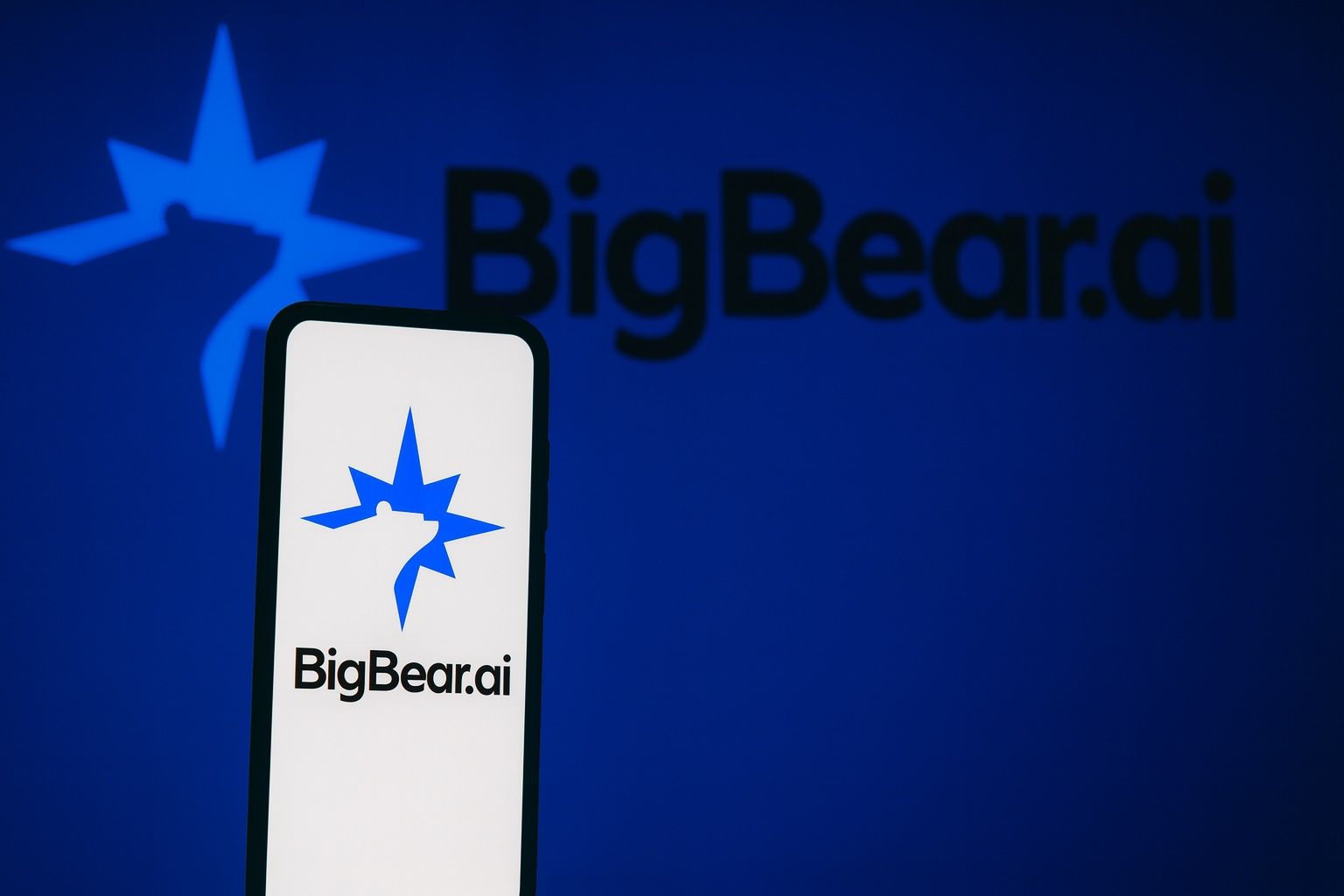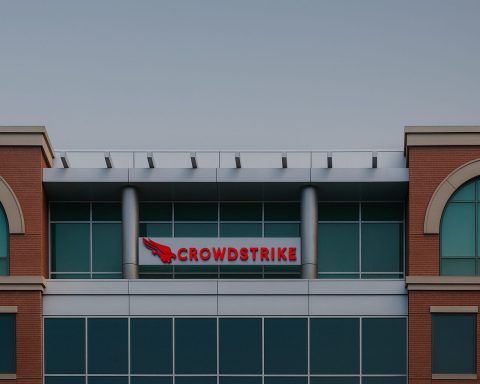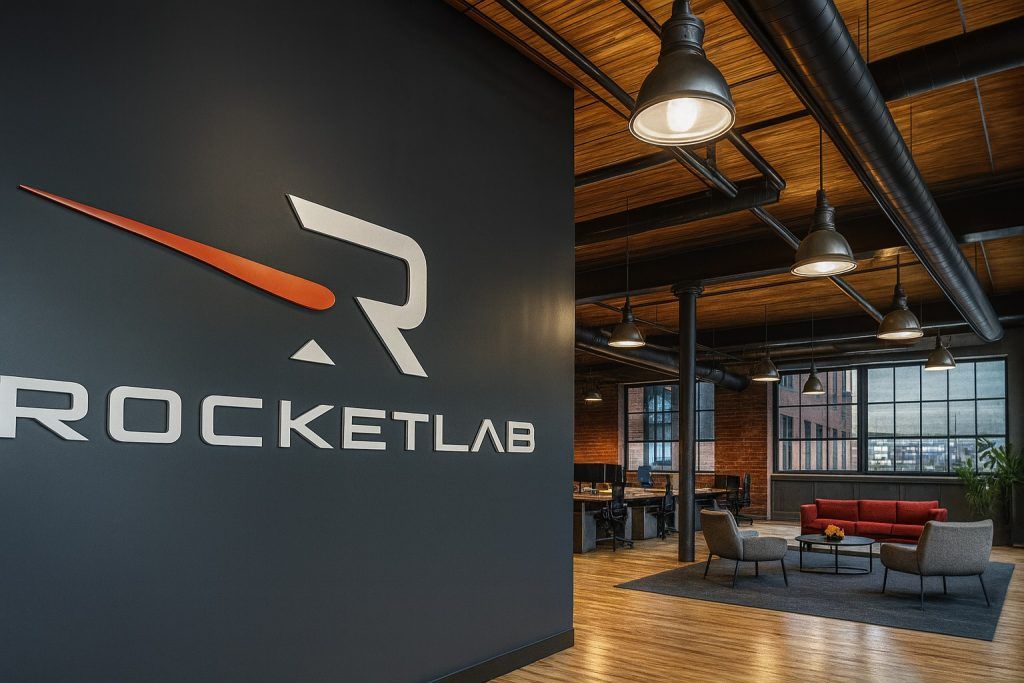BigBear.ai (NYSE: BBAI) is a “mission-ready AI” company focused on defense, national security and critical infrastructure [1] [2]. – The stock has been extremely volatile: after a rocky summer it jumped sharply in fall 2025, rising roughly 78–82% year-to-date (as of late Sep) and about 422% over 12 months [3]. – As of Oct. 9, 2025, BBAI closed around $7.49 per share [4] (up ~2.9% on the day), down from its all-time high (~$16.12 in Apr 2022 [5]). – Recent deals: partnerships include the U.S. Navy UNITAS 2025 exercise with SMX (AI for maritime awareness) and a biometric customs pilot at Nashville airport [6] [7]. – Q2 2025 results: revenue fell 18% YoY to ~$32.5M, net loss was $228.6M (mainly one-time charges) [8] [9], and management cut full-year guidance. – The company ended Q2 with $390.8M cash and ~$380M backlog [10] – giving a cushion despite losses. – Analysts are mixed: Consensus is a “Hold” (2 Buys, 2 Holds, 1 Sell) with an average 12-month target around $5.80–6.00 [11] [12]. Bullish analysts (H.C. Wainwright, Cantor) see upside (~$6–8) from government AI spending [13] [14]. – Technicals: BBAI is extremely volatile (implied volatility ~136% [15]) and recently overbought; some charts warn of a pullback. – Competition: It’s often compared to Palantir and C3.ai (larger government-AI firms) but faces questions about scalability. BigBear’s niche one-off solutions yield much lower margins (~25–30%) and slower growth than peers [16].
Company Overview
BigBear.ai is a publicly traded AI firm (NYSE: BBAI) based in McLean, Virginia, specializing in “mission-ready AI” solutions for the U.S. government and critical infrastructure [17] [18]. Founded via a 2021 SPAC deal, it leverages machine learning and data analytics to support defense, intelligence, homeland security, and even civilian border/trade operations. In practice this means projects like battlefield decision-support, border-security surveillance, supply-chain monitoring, and identity verification (biometrics). The company’s technologies include the Arcas™ computer-vision system and ConductorOS platform (AI orchestration for edge and “denied” environments), which CEO Kevin McAleenan says provide near-real-time predictive insights to operators [19] [20]. In short, BigBear.ai pitches itself as a specialized AI analytics vendor – a smaller, defense-focused counterpart to names like Palantir [21] – with decades of government contracting expertise. Its customers span the Department of Defense, DHS, and various allied agencies, and it has also branched into commercial deployments (e.g. biometric entry at airports).
Stock Performance
BigBear.ai’s stock has been on a wild ride. After languishing below $2 per share in late 2024, the stock exploded higher in 2025. From late summer into fall 2025, BBAI’s share price surged roughly 80% on strong investor interest. In late September it briefly topped $8 after the Navy deal [22], and it closed at about $7.49 on Oct 9, 2025 [23]. This represents around a 78–82% gain YTD and a 422% gain over one year [24]. By comparison, at its April 2022 peak BBAI traded above $16 [25], so the stock is still far below those highs.
The rally has come in sharp bursts. For example, on Sept 23 news of the Navy UNITAS exercise lifted the stock ~12% intraday [26]. In contrast, the Q2 earnings miss in mid-August caused a roughly 20–25% one-day plunge [27]. Volatility remains extreme: late Sep swings saw daily moves over 10–14%, with RSI indicators hitting overbought levels [28] [29]. Trading volumes have spiked around news events – Sept rally days saw volume double the norm – then softened quickly [30] [31]. In short, the momentum is undeniable, but technical indicators (e.g. high implied volatility ~136% and overbought RSI [32]) suggest caution: many analysts note that the September rally may not be sustainable without further catalysts.
Recent Developments (Oct 2025 and Prior)
BigBear.ai has been in the headlines for a flurry of new contracts and partnerships. The biggest was announced Sept 23, 2025: a collaboration with digital solutions firm SMX to support the U.S. Navy’s UNITAS 2025 exercise [33]. In this multinational maritime drill, BigBear will deploy its AI-powered sensor fusion and domain-awareness tools to help allied navies track illicit trafficking and improve situational awareness [34] [35]. CEO McAleenan said this “underscores BigBear.ai’s commitment to equipping U.S. and allied forces with mission-ready AI” [36]. That same release also highlighted Arcas™ and ConductorOS being tested aboard unmanned systems during the exercise [37].
Earlier, on Sept 11, BigBear announced that U.S. Customs at Nashville International Airport had begun using its biometric “veriScan” system to speed up passenger processing [38]. BigBear described this as enhancing traveler experience by letting eligible citizens bypass passport checks with facial ID [39]. Both deals (UNITAS and Nashville) helped bolster the company’s profile. Other notable initiatives mentioned by the company include a 2024 $165M U.S. Army contract (for Smart Camera Task Force support) and partnerships in the Middle East and Panama to apply AI to customs and cargo security [40] [41]. The firm also inked a naming-rights deal with the NFL’s Washington Commanders, dubbing their practice facility the “BigBear.ai Performance Center” [42] – a move seen as branding rather than material revenue.
On the financial side, BigBear lowered its 2025 guidance after Q2. Management now expects roughly $125–$140M in 2025 revenue (down from prior $160–$180M guidance) [43], and has withdrawn EBITDA targets amid uncertainty. The stock’s resilience despite weak earnings has been attributed to the high-profile defense deals announced in September; Motley Fool’s Daily Stock News notes that these partnerships “offset concerns from August’s earnings miss and reinforced investor confidence in the company’s long-term positioning” [44].
Analyst Commentary & Forecasts
Wall Street sentiment on BigBear.ai is mixed-to-cautiously optimistic. Analysts acknowledge the execution challenges, but many still see potential from federal AI spending. For example, Cantor Fitzgerald’s Jonathan Ruykhaver recently reiterated a Buy rating and slightly raised his target to $6, citing BigBear’s ~$380M contract backlog (up 43% YoY) and strategic acquisitions (e.g. Pangiam) [45]. Ruykhaver concluded that “BigBear.ai is well-positioned to establish itself as a leading AI/ML platform provider in the intelligence space” [46]. Similarly, H.C. Wainwright’s Scott Buck kept a Buy rating (though trimming his target to $8) and noted that BigBear’s Q2 miss was not surprising given contract delays; Buck emphasized that the company could benefit from the new $300B+ “One Big Beautiful Bill” federal defense/AI budget [47]. In his words, “Longer term, BigBear.ai is well-positioned to benefit from the One Big Beautiful Bill” [48].
However, analyst consensus is far from unanimous. MarketBeat reports 5 analysts covering BBAI in the past year: 2 Buys, 2 Holds, 1 Sell, yielding an overall “Hold” consensus [49]. Their average 12-month price target is only $6.00, implying about 20% downside from the current price [50]. (The high target is $8.00 and the low $4.00 [51].) TipRanks similarly notes a Moderate Buy consensus (2 Buys, 1 Hold) but with an average target of $5.83 [52]. By contrast, data aggregator AlphaSpread shows Wall Street’s mean 1-year target at just $4.85 (range $1.52–$8.40) – a 35% average decline from today [53].
In summary, short-term forecasts hinge on technical factors: many analysts caution that BBAI may consolidate or pull back after the recent run-up (given the overbought RSI and cooling volumes [54]). Over the medium term (next 6–12 months), projections depend on BigBear landing more contracts and improving financials. If the company can leverage its cash reserve (now $390M [55]) to invest in growth and margin expansion, optimistic analysts see upsides in the $6–8 range [56] [57]. Otherwise, skeptics point to its low gross margins (~25–30%) and slow revenue growth as reasons the stock may struggle toward its current levels.
Technical & Fundamental Analysis
On the fundamental side, BigBear.ai remains unprofitable and still absorbing growth pains. Its Q2 2025 report showed revenue of only $32.5M (down 18% YoY) [58], missing analyst estimates (~$41M) due to lags on U.S. Army contracts. The GAAP net loss was $228.6M [59], driven largely by non-cash charges (≈$135.8M from convertible-note revaluations and $70.6M goodwill impairment) that skewed the quarter’s results. Excluding these, the underlying business still produced a negative Adjusted EBITDA of about –$8.5M [60], worse than a year ago, thanks to lower margins (gross margin fell to ~25.0%) and higher R&D spend. Thus far BigBear has yet to demonstrate clear path to profitability: annual revenues have been growing in the single digits (3% CAGR last 3 years [61]) while expenses remain elevated.
On the balance sheet, however, the picture is strong: Q2 cash was $390.8M [62] (up sharply from prior year thanks to financings), and long-term debt remains relatively modest. A record $380M contract backlog provides some revenue visibility [63]. Valuation-wise, BigBear trades at high multiples (about 13× 2025 sales [64]) and carries a history of dilution, which worries some value investors.
Technically, BBAI has been a trader’s stock. The late-Sep rally was broad-based across brokers, but analysts note warning signs. The September run-up featured multiple 10%+ moves on heavy volume [65] [66], but end-of-run data showed waning volume and overbought momentum. By late September, the Relative Strength Index (RSI) was in overbought territory [67], and implied volatility soared (currently ~136%, far above tech-average) [68]. In fact, stockcharts show price swings as large as 14% in a single day [69]. Short-term traders should note these extremes: some technical analysts suggest a cooling-off or brief pullback is likely, even if the longer-term uptrend remains intact. Longer-term chart-watchers will also compare BBAI’s pattern to other AI/meme-type stocks which have moved in big spurts followed by corrections.
Market Positioning and Competition
BigBear.ai occupies a niche in the booming government-AI sector. It’s often likened to a “mini-Palantir” because both sell data analytics to defense and intelligence agencies. However, unlike Palantir’s scalable software platforms, BigBear usually builds custom, mission-specific solutions – which means far lower gross margins. TS2 notes BigBear’s margins are only about 25–30%, versus ~80% for Palantir [70]. Similarly, BigBear’s revenue growth (sub-10% annual) has trailed Palantir’s (which grew ~85% over a comparable period) [71]. Palantir now sells over $1 billion per quarter [72], dwarfing BigBear’s ~$32M/qtr.
Other AI-focused defense peers include C3.ai (which serves government and enterprise) and even voice-AI specialist SoundHound (though the latter is a very different business). TS2 notes that competition also comes from “C3.ai and other emerging players” in the AI analytics space [73]. Traditional defense contractors (like Booz Allen Hamilton, Leidos, etc.) are also starting to infuse AI into their offerings. BigBear’s chief advantage is its deep U.S. government ties and experience in complex mission environments. But to justify its stock valuation, it must scale up. Without dramatically expanding its client base or profit margins, it will remain a smaller fish in a pond with giants like Palantir and big-cap defense tech.
Sources: Authoritative news and filings as cited above; BigBear.ai press releases [74] [75]; specialized analysis (TechSpace2.0) [76] [77]; financial news and analyst data [78] [79] [80]. Each fact above is backed by cited reporting or statements.
References
1. ir.bigbear.ai, 2. ir.bigbear.ai, 3. ts2.tech, 4. www.nasdaq.com, 5. www.tradingview.com, 6. ir.bigbear.ai, 7. ir.bigbear.ai, 8. ts2.tech, 9. ts2.tech, 10. ts2.tech, 11. www.marketbeat.com, 12. www.tipranks.com, 13. ts2.tech, 14. www.tipranks.com, 15. ts2.tech, 16. ts2.tech, 17. ir.bigbear.ai, 18. ir.bigbear.ai, 19. ir.bigbear.ai, 20. ir.bigbear.ai, 21. ts2.tech, 22. ts2.tech, 23. www.nasdaq.com, 24. ts2.tech, 25. www.tradingview.com, 26. ts2.tech, 27. ts2.tech, 28. ts2.tech, 29. ts2.tech, 30. ts2.tech, 31. ts2.tech, 32. ts2.tech, 33. ir.bigbear.ai, 34. ir.bigbear.ai, 35. ir.bigbear.ai, 36. ir.bigbear.ai, 37. ir.bigbear.ai, 38. ir.bigbear.ai, 39. ir.bigbear.ai, 40. ts2.tech, 41. ts2.tech, 42. ts2.tech, 43. ts2.tech, 44. www.nasdaq.com, 45. www.tipranks.com, 46. www.tipranks.com, 47. www.tipranks.com, 48. www.tipranks.com, 49. www.marketbeat.com, 50. www.marketbeat.com, 51. www.marketbeat.com, 52. www.tipranks.com, 53. www.alphaspread.com, 54. ts2.tech, 55. ts2.tech, 56. ts2.tech, 57. www.tipranks.com, 58. ts2.tech, 59. ts2.tech, 60. ts2.tech, 61. www.alphaspread.com, 62. ts2.tech, 63. ts2.tech, 64. financhill.com, 65. ts2.tech, 66. ts2.tech, 67. ts2.tech, 68. ts2.tech, 69. ts2.tech, 70. ts2.tech, 71. ts2.tech, 72. ts2.tech, 73. ts2.tech, 74. ir.bigbear.ai, 75. ir.bigbear.ai, 76. ts2.tech, 77. ts2.tech, 78. www.nasdaq.com, 79. www.tipranks.com, 80. www.marketbeat.com










